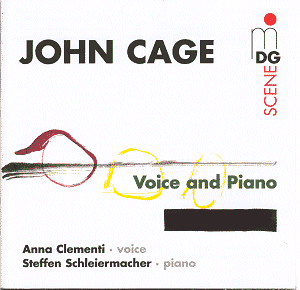Dabringhaus und Grimm’s series of Cage piano music
is an outstanding addition to the catalogue, and this disc of music
for voice merely reiterates the hypnotic beauty and seemingly endless
invention of this composer’s music. The excellent vocalist (voice ranges
do not mean much in reference to this music) is Anna Clementi, the daughter
of composer Aldo Clementi (who incidentally was an acquaintance of Cage).
Whereas Cage’s piano music takes up a multiplicity
of discs, the works for voice and piano can be accommodated on one.
And a fascinating disc it is, too. Here is a record that invites (or
even necessitates) repeated listening for the pieces to slowly yield
their secrets to the listener.
Four Walls, which takes up just under an hour
of the total playing time, was written for a choreography for Merce
Cunningham. It was premiered in August 1944, but seems to have been
pretty much neglected since. Satie-influenced in its emphasis on repetition
of certain chords and sequences, it limits itself to the white keys
of the piano, voice and piano are not even heard together: the vocal
contribution is limited to a solo ‘Interlude’ of under three minutes’
duration to a text by Cunningham (texts are unfortunately not included),
so the emphasis is laid most definitely at Schleiermacher’s door. As
always, this pianist plays with the utmost sensitivity. He is clearly
steeped in this music and it is from this that his ability to communicate
stems. Much of Four Walls is deceptively simple and Schleiermacher
has the ability to make this element speak volumes: he plays single
lines absolutely compellingly. No less impressive, and intimately related
to this, is the fact that silences (as always an integral part of Cage’s
musical lexicon) are grippingly held. Cage’s gripping use of registral
extremes (nowhere more excitingly heard than in the final Scene XII)
is most telling. Throughout one can hear the care Schleiermacher put
in to this performance. He exudes total concentration; the voicing and
weighting of his chords is consistently fascinating; his repetition
of Cage’s obsessively repeated units is hypnotic.
Anna Clementi has much more to do in the remaining
pieces on the disc. A Flower (1950, wordless) and The Wonderful
Widow of Eighteen Springs (1942, text James Joyce, from Finnigan’s
Wake) are both written for ‘Voice and Closed Piano’: the pianist’s
role is to drum precisely-notated rhythms out on the piano-lid (quite
simple in the former piece, more complex in the latter). The effect
is of voice accompanied by muted bongos, whose rhythms comment upon
but never overtly contradict the vocal patterns. A Flower includes
some witty ‘quacking’ noises from the vocalist, but its main effect
is almost of a vocal imitation of a shakuhachi, the disembodied meanderings
of the vocal line almost impossibly beautiful.
Clementi despatches the solo Experiences II (1944-48,
text e. e. cummings) with an artless simplicity that gives it a true
folk-music quality, the only difference being the (typically Cageian)
long silences between verses. She is asleep (1943, for voice
and prepared piano) is part of an unfinished composition. The pianist’s
part is based on only four notes (the piece lasts 6.54), but Cage’s
manipulation of these pitches and the voice (including vocal effects)
is gripping.
What many people interpret as typical Cage is seen
in the overt gesturalism of Nowth upon Nacht (1984, text James
Joyce, in memoriam Cathy Berberian). The pianist’s role is to slam the
piano-lid three times. The first inaugurates the piece, followed by
half shouted-half screamed declamation of Joyce’s text. Perhaps Anna
Clementi’s response is not quite as visceral as Cage intended it, but
it’s close. Indeed, throughout Anna Clementi’s contribution is as sensitive
as it is wide-ranging. She can capture the artless simplicity of the
folk-song like pieces as easily as the more demanding, demonstrative
ones.
Schleiermacher’s devotion to this repertoire is obvious.
His technique seems to know no bounds (see also my review
of his disc of music of the Darmstadt School, also on Dabringhaus and
Grimm), and he has immersed himself in Cage’s world so much that this
music comes out as second nature.
This Dabringhaus und Grimm issue would actually serve
as a perfect one-disc introduction to the world of John Cage, and hopefully
will direct listeners in the direction of the rest of their ongoing
Cage project. Unhesitatingly recommended.
Colin Clarke

![]() Anna Clementi (voice);
Steffen Schleiermacher (piano).
Anna Clementi (voice);
Steffen Schleiermacher (piano). ![]() MUSIK DABRINGHAUS UND
GRIMM - SZENE MDG613 1076-2 [76.47]
MUSIK DABRINGHAUS UND
GRIMM - SZENE MDG613 1076-2 [76.47]